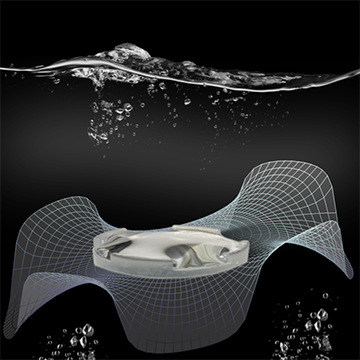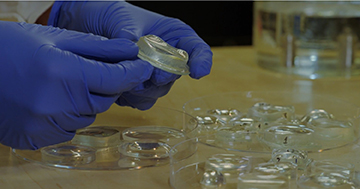
Researchers at the Technion, Israel, have demonstrated a method for fabricating freeform optical components with sub-nanometer surface roughness within minutes by shaping liquid volumes. [Image: Technion–Israel Institute of Technology]
Freeform optical surfaces lack the translational or rotational symmetry of traditional lenses and thus require expensive, specialized manufacturing equipment to create. Now, researchers in Israel have bypassed the need for complex fabrication by shaping curable liquid polymer inside a buoyant bath of a different liquid (Optica, doi:10.1364/OPTICA.438763).
With the new process, creating a freeform optical component—from 3D-printing a frame to solidifying the polymer—takes less than an hour and yields a surface with sub-nanometer roughness, similar to the best polishing technologies. The method could lead to rapid prototyping of design concepts as well as mass production of complex optics for many types of imaging applications.
Liquid in liquid
Research team leader Moran Bercovici, a mechanical engineering professor at the Technion–Israel Institute of Technology, and a colleague had already explored the fabrication of simple spherical and aspherical lenses in immiscible liquids (Flow, doi:10.1017/flo.2021.1). They submerged a ring into a mixture of water and glycerol, then injected polymer into the interior of the ring. After the forces of gravity and buoyancy stabilized the shape, the researchers cured the polymer with ultraviolet (UV) light, resulting in a solid, smooth-surfaced lens.
In the Optica paper, Bercovici, Technion grad student Mor Elgarisi and their collaborators changed the boundary conditions of the desired lens—and the corresponding shape of the 3D-printed frame that would form the basis of the lens. They calculated the balance of gravitational, hydrostatic and surface-tension forces that would shape the interface between the two liquids (polymer and water-glycerol solution). They did calculations with varying Bond numbers, which represent the ratio of gravity to surface tension in the polymer.
The method reportedly can fashion optical components with various geometries, including toroid and trefoil shapes, and sizes up to 200 mm as well as freeform surfaces. [Image: Technion–Israel Institute of Technology] [Enlarge image]
Next, the researchers attached a flat glass plate to the bottom of the frame and placed it into a container of immersion liquid (26.8% glycerol, 73.2% deionized water), which would give the liquid polymer a Bond number of 3. After the injection of polymer resin into the immersed frame, the team waited for it to relax, or come to a stable and non-fluctuating surface, before shining 365-nm-wavelength lamps on it for 5 minutes to solidify the polymer.
The researchers suggested additional twists to the method, such as exposing different ends of the frame to immersion liquids with different Bond numbers to change the shape of the freeform lens. They are also trying various optical polymers and exploring ways to automate the fabrication process.

